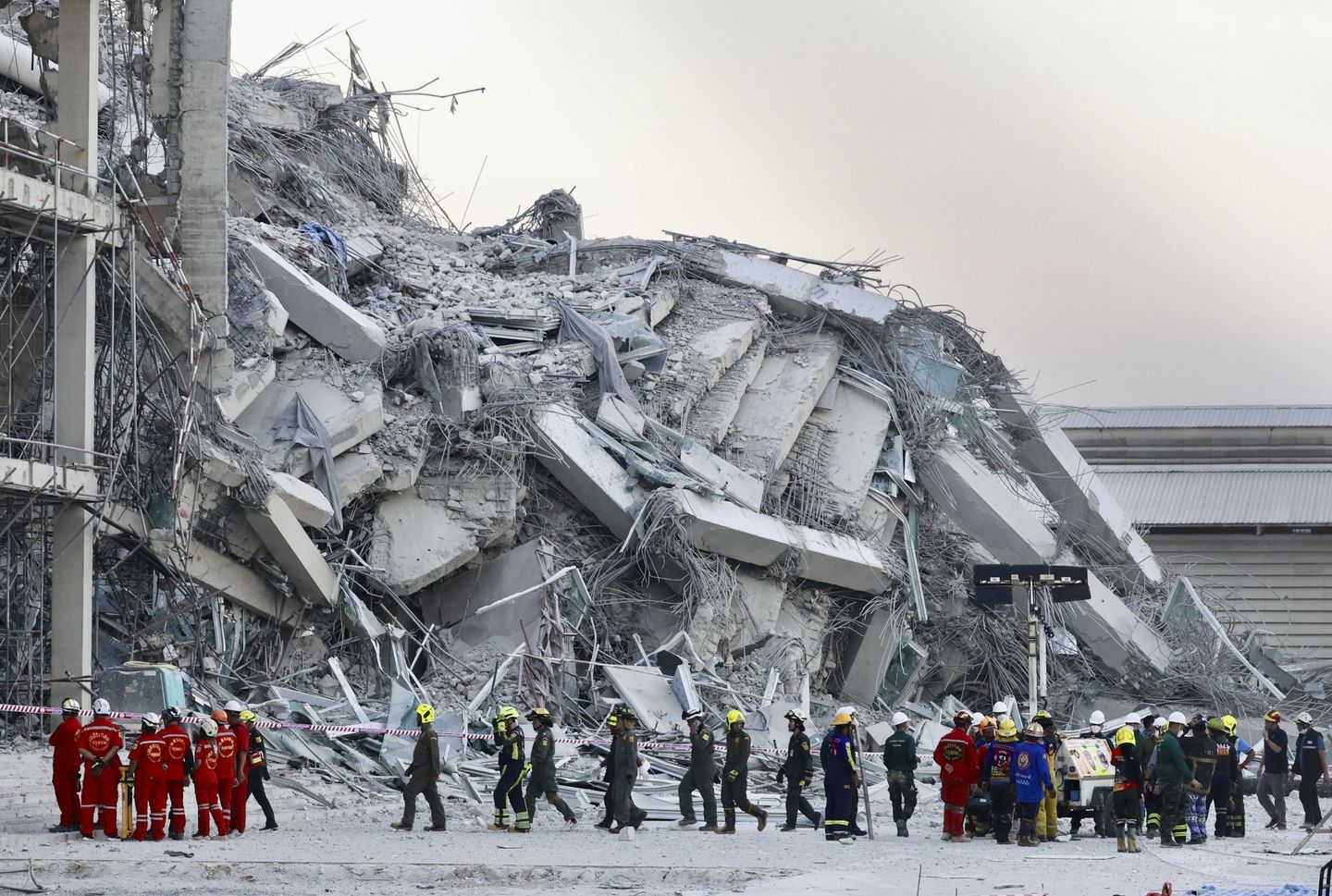
BANGKOK, Thailand — China’s global Belt and Road Initiative is under intense scrutiny here after just one structure in the Thai capital collapsed in last week’s earthquake: a 30-floor building under construction by the communist country.
The wreckage of the incomplete skyscraper — one piece of the worldwide infrastructure initiative that is a key component of Beijing’s soft diplomacy strategy — exposed what some analysts said was evidence of substandard construction.
Steel reinforcing rods exposed in the collapse appear to have snapped under the strain of the earthquake, reducing the building, which was being built for Thailand’s State Audit Office by a Chinese company and a Thai construction firm, to a huge pile of rubble.
There have been 15 confirmed deaths and 72 workers are still missing.
“I watched multiple clips of the building collapse from different angles,” a stunned Thai Prime Minister Paetongtarn Shinawatra said. “From my experience in the construction industry, I have never seen an issue like this.
“We must investigate thoroughly because a significant portion of the budget was allocated, and the deadline for completion had been extended,” Ms. Paetongtarn said.
The investigation began with a bizarre, troubling sight.
Two days after the earthquake, four Chinese men were captured on video grabbing as many construction-related documents as they could carry and running from the rubble site.
Police detained, questioned and released them. China’s embassy in Bangkok and Thailand’s powerful interior ministry, which oversees the police, met to discuss the skyscraper collapse but their talks were not made public.
China’s image in Thailand is seen as critically important for Beijing, which has been competing unofficially with Washington for decades to influence Bangkok’s diplomacy, politics, economy and military.
China has fostered economic ties to Bangkok with education, investment, tourism and financial aid.
In the collapsed skyscraper’s debris, investigators extracted two types of steel reinforcing bars, also known as rebars, that were supposed to provide support for the building while encased in cement pillars.
After the earthquake, the Iron and Steel Institute of Thailand reportedly discovered the chemical composition, mass and stress strength of the rebars appeared to fail its tests.
Photographs displayed by the ministry and local media showed a brand name embossed on a steel rebar dug out of the wreckage linked to a Chinese steel-making company.
Concern about China’s role in the unfinished skyscraper’s deadly collapse comes at a time when some Thais have expressed anxiety about Beijing’s increasing reach into the country’s development.
Thailand’s sophisticated tourism industry, multi-billion-dollar high-rise condominium and construction market, insurance companies and other sectors have all taken a hit since the earthquake.
The Southeast Asia nation faces an estimated loss of more than $1 billion from the quake, economists said. At least 30 high-rise buildings in Bangkok were damaged and deemed uninhabitable, the Public Works Department said Wednesday.
Thailand’s government institutions for inspecting building contracts, design plans and materials used in construction, and its anti-corruption policies, are being criticized by the public and Thai media for having been unable or unwilling to correct problems at the doomed skyscraper.
Many Thais noted, with grim irony, that the only building to collapse in Bangkok was to be the new home for the State Audit Office.
That government agency is tasked with preventing fudged contracts and dodgy government-linked projects, The Facebook page of the State Audit Office was inaccessible Wednesday after the agency came under heavy criticism and was accused of corruption.
The construction contract was a joint project between the Chinese government’s China Railway No. 10 Engineering Group and Thailand-based Italian-Thai Development, the largest construction company in Thailand and one of the largest in Southeast Asia.
China Railway No. 10 Engineering Group is part of China Railway Engineering Corp., or CREC, one of the biggest engineering and construction firms in the world.
CREC and Railway No. 10 are pieces of the Belt and Road Initiative, Beijing’s sprawling international development and financial expansion project. CREC’s projects for the initiative include China’s impressive Beijing-Shanghai and Qinghai-Tibet railways and, in East Africa, the Mombasa-Nairobi railway across Kenya.
CREC is an enterprise owned by the communist Chinese government and has completed other projects in Thailand, including rail tracks for a link in what will eventually become a high-speed line connecting Beijing and Singapore via Bangkok. It also helped construct one of Bangkok’s underground metro lines and was bidding for others.
The Commerce Ministry, Royal Thai Police Economic Crime Suppression Division and Revenue Department meanwhile reportedly opened investigations into a dozen other projects in Thailand possibly linked to CREC and China Railway No. 10.
Before the quake, CREC proudly heralded the Bangkok SAO skyscraper construction contract as the “first high-rise building for the bureau overseas.”
Philip J. Cunningham, a researcher of Asian politics in media, said CREC’s website, after the earthquake, deleted photos, quotes and other pages related to the SAO building including CREC’s earlier announcement.





![Trump's Admin Guts Another ‘Rogue Government Agency with Zero Accountability’ [WATCH]](https://www.right2024.com/wp-content/uploads/2025/03/Trumps-Admin-Guts-Another-‘Rogue-Government-Agency-with-Zero-Accountability-350x250.jpg)



![‘We All Owe Him (Elon) a Huge Debt of Gratitude’ [WATCH]](https://www.right2024.com/wp-content/uploads/2025/03/‘We-All-Owe-Him-Elon-a-Huge-Debt-of-Gratitude-350x250.jpg)
![NCAA Champ Salutes President Trump After ‘BIGGEST UPSET IN COLLEGE WRESTLING HISTORY’ [WATCH]](https://www.right2024.com/wp-content/uploads/2025/03/NCAA-Champ-Salutes-President-Trump-After-‘BIGGEST-UPSET-IN-COLLEGE-350x250.jpg)






